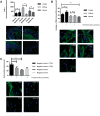Scleroderma keratinocytes promote fibroblast activation independent of transforming growth factor beta
- PMID: 28968684
- PMCID: PMC5850806
- DOI: 10.1093/rheumatology/kex280
Scleroderma keratinocytes promote fibroblast activation independent of transforming growth factor beta
Abstract
Objectives: SSc is a devastating disease that results in fibrosis of the skin and other organs. Fibroblasts are a key driver of the fibrotic process through deposition of extracellular matrix. The mechanisms by which fibroblasts are induced to become pro-fibrotic remain unclear. Thus, we examined the ability of SSc keratinocytes to promote fibroblast activation and the source of this effect.
Methods: Keratinocytes were isolated from skin biopsies of 9 lcSSc, 10 dcSSc and 13 control patients. Conditioned media was saved from the cultures. Normal fresh primary fibroblasts were exposed to healthy control and SSc keratinocyte conditioned media in the presence or absence of neutralizing antibodies for TGF-β. Gene expression was assessed by microarrays and real-time PCR. Immunocytochemistry was performed for α-smooth muscle actin (α-SMA), collagen type 1 (COL1A1) and CCL5 expression.
Results: SSc keratinocyte conditioned media promoted fibroblast activation, characterized by increased α-SMA and COL1A1 mRNA and protein expression. This effect was independent of TGF-β. Microarray analysis identified upregulation of nuclear factor κB (NF-κB) and downregulation of peroxisome proliferator-activated receptor γ (PPAR-γ) pathways in both SSc subtypes. Scleroderma keratinocytes exhibited increased expression of NF-κB-regulated cytokines and chemokines and lesional skin staining confirmed upregulation of CCL5 in basal keratinocytes.
Conclusion: Scleroderma keratinocytes promote the activation of fibroblasts in a TGF-β-independent manner and demonstrate an imbalance in NF-κB1 and PPAR-γ expression leading to increased cytokine and CCL5 production. Further study of keratinocyte mediators of fibrosis, including CCL5, may provide novel targets for skin fibrosis therapy.
Keywords: CCL5; NF-κB; PPAR-γ; TGF-β; fibroblast; keratinocyte; scleroderma.
© The Author 2017. Published by Oxford University Press on behalf of the British Society for Rheumatology. All rights reserved. For Permissions, please email: journals.permissions@oup.com
Figures




References
-
- Lawrence RC, Helmick CG, Arnett FC. et al. Estimates of the prevalence of arthritis and selected musculoskeletal disorders in the United States. Arthritis Rheum 1998;41:778–99. - PubMed
-
- Chifflot H, Fautrel B, Sordet C, Chatelus E, Sibilia J.. Incidence and prevalence of systemic sclerosis: a systematic literature review. Semin Arthritis Rheum 2008;37:223–35. - PubMed
-
- Al-Dhaher FF, Pope JE, Ouimet JM.. Determinants of morbidity and mortality of systemic sclerosis in Canada. Semin Arthritis Rheum 2010;39:269–77. - PubMed
-
- Shand L, Lunt M, Nihtyanova S. et al. Relationship between change in skin score and disease outcome in diffuse cutaneous systemic sclerosis: application of a latent linear trajectory model. Arthritis Rheum 2007;56:2422–31. - PubMed
MeSH terms
Substances
Grants and funding
LinkOut - more resources
Full Text Sources
Other Literature Sources
Medical
Molecular Biology Databases
Miscellaneous

